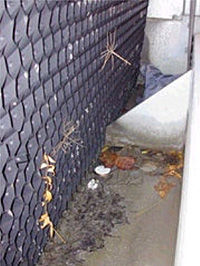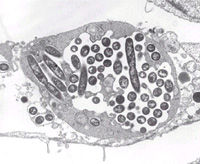By Randy Simmons
The following is an important reminder of the need for all companies that use cooling towers, to adopt and keep diligent in their maintenance and water treatment program. Why? because what’s at stake is a companies worker health and safety, the company’s reputation and operational efficiency; these can be dramatically affected by the unsafe condition of a single cooling tower.
How a Legionella Tragedy Can Happen

Cooling Tower Basin With High Organic Debris Content
When organic debris such as cottonwood seed, leaves, insects, pollen, grass, birds and their droppings, etc. get into the water and decompose, it along with the relatively warm temperatures of the water create a nutrient rich environment for bacterial growth including Legionella. Further, it’s important to recognize that if the volume of decomposing debris exceeds the chemical dosage’s ability to provide control, the cooling tower will silently grow dangerous even while chemical dosing continues. The fact of the matter is that it’s easy for companies to develop a false sense of security that their cooling towers are safe either because they are treating the water themselves or, because they’ve hired a water treatment service to establish dosage levels that should ensure the tower is safe. In either case, if organic debris management isn’t in alignment with water treatment dosage levels and made integral to the maintenance process, there is an increased probability of the tower becoming a health and safety hazard. It doesn’t matter how large or small a company or a cooling tower is; bacteria including Legionella doesn’t discriminate – it will thrive in any poorly managed cooling tower!
An Obvious Question

This photo shows serious maintenance neglect. Tower has high organic content and heavy scaling. This tower is a health and safety hazard.
How to Keep a Safe Cooling Tower

Legionella as found in cooling towers and boiler sytems
Photo Compliments of Centers for Disease Control

Photo shows the air intake filtration method of managing airborne debris
When determining what maintenance and debris management technology to use, it is important to first determine what the source of debris is. If the source of debris is waterborne (e.g.; sediment, algae from pond or river, or water with high dissolved solids content), water filtration in combination with a good water treatment program is typically the best solution and will protect the chiller and heat exchanger from scaling and fouling. If on the other hand, the source of debris is airborne related (cottonwood seed, insects, leaves, pine needles, paper, birds & droppings, harvest chaff, construction debris, etc), then water filtration systems will not stop the debris from getting into the cooling tower (especially the fill). For airborne debris related problems, the best solution is to prevent the debris from getting into the system by using air intake filtration technology that filters the air as it enters the system. Air intake filtration in combination with a good water treatment program is highly effective in stopping the kind of debris that clogs strainers, blow down valves, fill, chillers and heat exchangers – In short, air intake filtration effectively protects the entire system. In extreme cases where both waterborne and airborne debris is problematic, both air intake filtration and water filtration in combination with a good water treatment program may be required in order to keep the cooling tower safe and operating efficiently.

Legionella Bacteria multiplying inside of cultured human lung tissue.
Photo Compliments of Centers for Disease Control
Personal Safety
No matter what procedures are adopted in maintaining cooling towers, personal safety precautions must be integral to the maintenance procedures. Best practices require workers to wear respirators, gloves and protective clothing to help prevent exposure to bacteria, especially Legionella. Important Note:cooling water doesn’t have to look dirty to be dangerous – just because the water is clear doesn’t mean it’s clean or free of bacteria – Every cooling tower can harbor bacteria. Always, always take precautions because unless the water is routinely tested for Legionella and other bacteria, the bacteria will never announce its presence until it’s too late.
Consider the Costs of a Sick Tower
Companies that don’t take appropriate precautions and insist upon diligent cooling tower maintenance procedures put not only their employees health and safety at risk, but also their business and reputation. Consider the cost of a single cooling tower related Legionella incident:
- Reduced employee moral and productivity due to an unsafe work environment.
- Negative customer perceptions of the company and their willingness to buy goods & services should a Legionella outbreak become public. (especially risky for food and related processors)
- Loss of income to families when a loved one becomes ill or die from Legionella.
- High cost for litigation which can follow.
- Higher company insurance costs when claims due to job related sickness or death occur.
In comparison to the cost of a proactive maintenance initiative, the incidents listed above when considered individually or collectively carry staggering cost.
Follow a Leader
So you may be wondering exactly how the major automotive company mentioned at the beginning took a tragic situation and turned it into a world-class maintenance program. They formed an oversight committee sponsored by executive management, that was charged with the responsibility of working with consultants, water treatment professionals and maintenance employees to establish a global water management program that encompasses specific maintenance tasks, maintenance methods & procedures, maintenance schedules, management accountabilities and reporting guidelines at the facility level. The representative at each facility is accountable to a regional representative who reports activities and results to the oversight committee. The establishment of the oversight committee and its global management network ensures uniformity of their program plus, gives the company a vehicle to quickly implement changes and enhancements that provide continuous improvement to their global water management program.
It Doesn’t Take Rocket Science
It simply requires that companies using cooling towers “step-up to the plate” and initiate proactive and on-going maintenance procedures that align effective debris management technology with effective water testing and treatment techniques because when these elements are in alignment, the result is a safe, healthy and efficient operation.
Randy Simmons is VP Marketing for Air Solution Company, Commerce Township, MI. a manufacturer of air intake filtration solutions. For questions or information, contact Randy at


